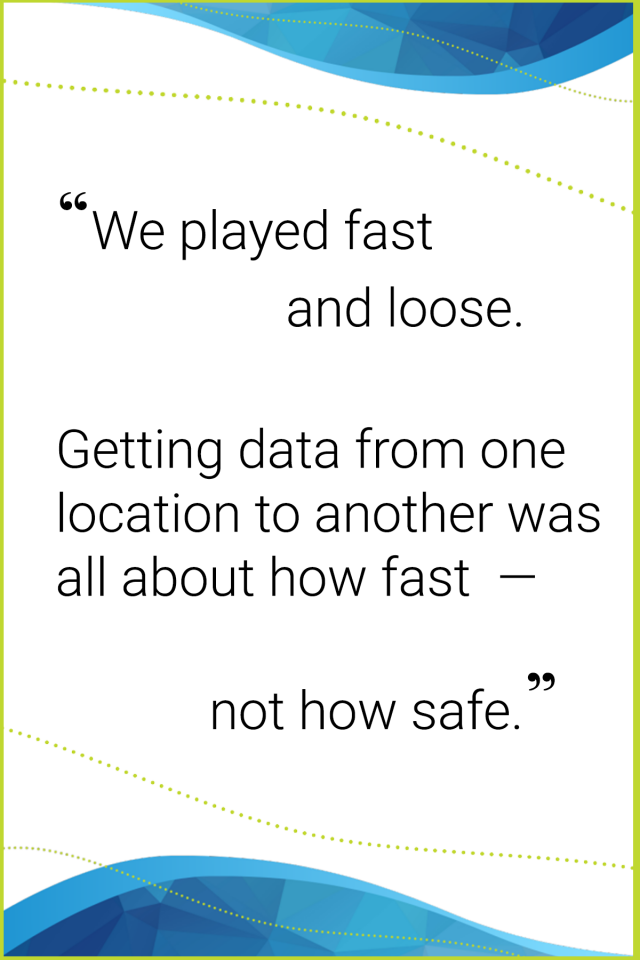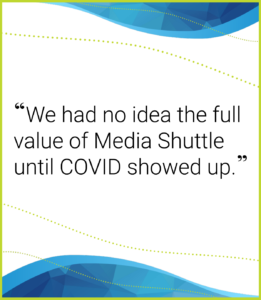Definition 6 Navigates COVID with Signiant Media Shuttle
“Well, this looks like things are getting worse,” Definition 6’s Manhattan-based chief engineer, Luis Albritton, recalled nearly a year later.
Like almost everyone worldwide, Definition 6, a digital and creative services company with offices split between New York and Atlanta, was staring into the reality of a widespread pandemic shutdown. The future of their enterprise relied on their teams being able to keep working.
But it could have been so much worse. With prescient foresight, Definition 6 had an advantage already in place.
Signiant spoke with Luis Albritton about how Media Shuttle helped them weather the chaos of COVID-19, the value it brings them, and what makes Shuttle a must-have for remote working.
Tell Us About Definition 6
We’re a creative marketing agency made up of curious content makers, creative developers, and innovative solvers. The customer experience is at the heart of everything we do. We listen, collaborate, and truly care about telling your story for your people. We’re all in.
The management of our company is in Georgia, and the television post-production wing of the company — audio, graphics, video — is in New York. It’s one of those locations in midtown Manhattan that’s very popular. The New York office is about 60 employees and the Atlanta office is another 100.
What kind of work do you do?
Definition 6 is known mostly as a promo house. We get large amounts of assets in the production pipeline at the beginning, and then the amount of assets [gets smaller] after that. We end up delivering a 30-second spot or 40-second spot at the end of our project. Sometimes a client says, “Look, not only do I want the finished product, I also would like to have the actual project.” So we could be delivering hundreds of gigs while on the ingest side there’s one, two, three terabytes of data.
You were using media shuttle before the pandemic. How did that come about?
Chris Reinhart, SVP of post-production, and myself had been lobbying to get Media Shuttle to our facility. What we were trying to figure out is how do we meet the security settings for taking the company to the next step of post-production workflows for people like Netflix, HBO, Cinemax — which were requiring this extra layer of complexity in our workflows and security. How do we get the access yet make it available in a way that’s secure for our clients and vendors?
That security and segregation of access was front of mind from the get-go. We have very close relationships with clients and broadcast partners that have signed on to the TPN partnership of broadcast, and we were always invited to their environments. We never had our own. It got to the point where we needed to get the access as fast as possible down from or up to our clients.
The company itself had grown to the point where not all of our own personnel could take on the amount of work that we were getting. So there was a component of “how can we rapidly expand our capabilities, make our capabilities available, and work with contractors securely?”

What were you using before Media Shuttle?
We used to have an FTP server. In those days, I would have the same password six months ago that I had today. We played fast and loose. Getting data from one location to another was all about how fast — not how safe. That layer of security is the part that takes a little bit of an education; you’ve got to teach them, “Listen, this is a new way.”
What does your environment look like today?
Media Shuttle at Definition 6 uses both on-prem as well as AWS storage integration. Decisions are made based on workflow and client requirements where to point our portals.
Our original deployment was a server sitting in our facility pointing to local storage on that server that very specific people in the company had access to.
Many different shares are secure in our storage; it’s high quality of service. When we are in the facility, nine editors are attached to a particular partition to edit. We now have nine different editors that can attach to that partition via Media Shuttle.
Tell us about a typical project
Our projects tend to be initially in the terabytes, and at the end, gigabytes. Since we took on a number of contractors, we had a ton of small files and deliverables constantly in motion. For instance, we don’t have a colorist in-house, so we were working with partners that were colorists that worked remotely from their homes. They couldn’t bring their rig into our environment every day to work, so we would make them a folder that they had access to. They would only have access to that specific Media Shuttle folder and only for the duration of the project.
How many users are using Media Shuttle?
Concurrently, at any given point, [we have] 20-30 internal users. Externally, add another 20. Massive traffic, big loads, big downloads — that all tends to happen towards the beginning of the week, because that’s usually when the production schedules get started.
The challenge is our external users who are not in the company. Media Shuttle allows us to limit their view in a way other solutions don’t. For instance, every single partition that we have in our Facilis [Terrablock] is available to anybody who’s a user in that storage. But when I go to create a Media Shuttle portal, external personnel that have nothing to do with the company itself never see the entire share. They see a folder inside my share. The folder that I allow them to see.
Can you describe a typical Media Shuttle workflow?
Once a job is awarded, a workspace is created in our shared storage solution. Access is assigned based on booked creative personnel. Next, a Media Shuttle portal is created to point into the storage and access granted to booked creative personnel
If a remote vendor provides the footage, we create “Submit Portals” to specific folders in the storage to control access and have logs of activity. If the client provides the footage, they are invited to the portal.
Once a given creative process is completed and the job delivered, there is an internal process for decommissioning the Media Shuttle Portal and any submit or download portals associated. This prevents any changes on the storage. Finally, archival to LTO tape begins. Once contents are verified, the storage share is released for reassignment to the next job in the cycle.
Workflows like this make our processes much easier and solve a range of challenges. With Media Shuttle, we have more access control with client content, on top of all of the traffic and access. That we no longer have to shuttle or ship drives from location shoots or client locations is fantastic!
It’s also made the remote conditions much easier to manage since we now have a centralized service sitting in our tech stack that’s accessible to our staff for their location while working remotely. Our clients also have total confidence that their media is safe, yet securely accessible if necessary.
Media Shuttle is just an incredibly adaptable product so we can stay assured that it will work with any new workflow that requires that agility of data movement.
What happened when the pandemic hit?
COVID-19 came in and we started realizing we had to work away from the facility. This meant an even greater need for security. What we decided to do was create folders for each individual client, and then designated which business leaders, editors, and producers would be overseeing those folders. But, as you can imagine, it was a bad day to have to suddenly be figuring all this out.
What was the impact of Media Shuttle during the pandemic?
We had no idea the full value of Media Shuttle until COVID showed up. We were fortunate. It’s very hard to quantify to somebody, who’s not in our space or our business, why you need a product like Media Shuttle. Signiant allowed us to expand our services to external users since the whole creative staff, vendors, and partners could not be physically together in the same space, and with so much speed and efficiency, I cannot stress that enough. The speed with which we can get data into this environment, and have editors ready to edit — it’s invaluable.
Our usage of Media Shuttle is only growing, too. We have expanded a great deal since we started segregating quality of service to cloud storage. This component of the service makes fast, reliable access to content securely easier than we could have imagined, and without having to integrate a new technology stack or train the users on a new deployment. The interface is the same to the end user but the quality of service increases greatly.
What would your COVID experience be like if you hadn’t already had Media Shuttle in place?
We would be scrambling to get something maybe more expensive. Maybe not as efficient. The reaction would have been, “The company will have to make decisions to survive. Everything that has to do with production will go ahead because you have to retain clients, you have to be able to meet the demands of your business.” Under the immense pressure and knowing the stakes, we would just be scrambling to find any solution to ensure that.
Then comes the question of where does that money come from, and the sacrifices. You might have to shrink your staff, You might have to meet the demands of other solutions that are out there, even if they’re less than ideal.

What do Signiant and Media Shuttle do for your business?
Media Shuttle and our company started as a proof of concept. We are way beyond proof of concept. This is an everyday tool, an everyday tool that I could not stress enough to my leadership — “without this, we’re not going to be able to do remote work”. That’s a professional opinion from 25 years of experience in this industry. There are technologies that we could adopt, but it will take more of a capital expenditure, initially.
Products like Media Shuttle make our company nimble. [We] can shift and rotate our workflows quickly and are able to meet the demands of what’s out there, when crisis happens.
That’s the kind of thing that keeps you competitive. That’s huge. That’s what keeps our industry moving forward. We don’t know what the next crisis will be, therefore reliance on tech partners that are willing to change with the times and develop solutions as the needs of the industry change is invaluable. I only see our deployment on Media Shuttle growing in scope.
This interview was edited and condensed for clarity.




